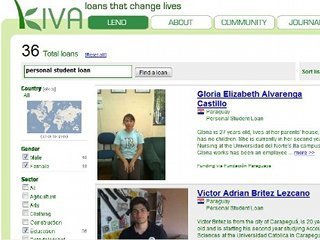
Correction: Kiva loans do not come with an average interest rate of 36%; the average Kiva field partner has a portfolio yield of 36%.
Kiva has long been one of my favorite websites. The concept of giving any average individual the legal channels and resources to quickly and easily lend money to an entrepreneur in a developing country with full transparency is revolutionary, to say the least. Founded in 2005, Kiva has facilitated more than 250,000 loans in 209 countries totaling more than $185 million to date. Kiva co-founder Jessica Jackley recently delivered a moving TED Talks lecture, in which she outlined Kiva’s mission to help alleviate global poverty while changing attitudes toward poverty. Jackley ended her lecture in tears and received a standing ovation from the audience.
But there is one lingering wrinkle in the Kiva business model that doesn’t really settle well with me: interest rates.
To be clear, Kiva does not, itself, charge any interest on the loans it facilitates. Interest is charged by Kiva’s 160 Field Partners who distribute funds to Kiva borrowers and collect loan repayments in the countries that Kiva serves.
While the average portfolio yield (which Kiva defines as “the average interest rate and fees borrowers pay”) of Kiva’s U.S. partners hovers somewhere around 10%, the average portfolio yield of an overseas partner is 36%. Some field partners have yields as high as 70%, and in May, Kiva parted ways with a field partner (LAPO in Nigeria) that had a portfolio yield of 83% and was seeing a 15% return on assets.
Julie Hanna, Chair of Kiva’s board of directors, told me via email that Kiva takes a number of measures to ensure that its borrowers are able to repay their loans without falling into overindebtedness. “The majority of partners in Kiva’s MFI portfolio are non-profit (NGOs) that are barely self-sustaining,” she said, adding that Kiva implements “an extensive due diligence and monitoring system that ensures that Microfinance partners meet interest rate and profitability requirements.”
The costs of running a microfinance organization in a region that is poverty-stricken, has poor roads, no phones, and may even be torn by violence, certainly isn’t cheap. But is it fair to put that price on the working poor in developing countries?
The massive interest rates that microfinance organizations charge has become the subject of a global debate as rising overindebtedness and a string of suicides in India has prompted many to demand stronger regulations of microlenders, who are now more akin to loan sharks than humanitarian groups. The Prime Minister of Bangladesh, Sheik Hasina Wazed, who formerly championed microfinance, has since called for the severe restriction of microlenders, who she accused of “sucking blood from the poor in the name of poverty alleviation.”
In the Indian state of Andhra Pradesh, which accounts for roughly one-third of the country’s total microloans, more than 70 people committed suicide between March and November 2010 to escape overwhelming debt, according to the Society for the Elimination of Rural Poverty.
In cultures with extreme power imbalances between men and women, women often suffer the consequences of overindebtedness due to predatory lending practices among microlenders. Women account for 70% of the world’s poor and make up the vast majority of borrowers– 97% of Grameen Bank borrowers are women and 82% of Kiva borrowers are women.
But several studies have found that gender discrimination and power imbalances result in more men benefitting from microcredit than women. One study conducted by MIT in India randomly gave out microloans to half of the families in its experiment while denying the other half and found that the women of the families who received microloans experienced no improvement in decision-making power in their families or self-reported well-being.
The microfinance organizations that are at the root of the crisis in India and Bangladesh, which account for half of the world’s microloan borrowers, are for-profit entities that have allegedly intimidated borrowers into taking out more than they could afford to pay back. Many of these specific organizations have turned mind-blowing profits. For example, SKS Microcredit, India’s largest microfinance organization, sold shares last year for as much as 95 times their original worth.
“Microfinance has been abused and distorted,” said Grameen Bank founder Muhammad Yunus, who is considered the founder of microfinance. “I feel so sad because that’s not the microcredit I have created.”
Kiva maintains that it thoroughly screens its Field Partners. The organization explains on its website: “When Kiva evaluates potential Field Partners, we carefully review their social mission: their interest rates, operating costs, loan sizes, populations served and other client based services (“micro-finance plus” services). We perform extensive reference checks and due diligence, making sure to look at how well Field Partners match our core values: Poverty Focus, Empowerment of Women, Commitment to Social Performance Management and whether there is a Client-Centric Culture.”
Kiva has long defended the interest rates charged by its field partners as necessary to their sustainability and Kiva’s continued facilitation of loans around the world, but this prompts some very basic questions about Kiva’s business model and philosophy. While microcredit has the capacity to help entrepreneurs in developing countries work their way out of poverty, is it fair to put the high cost of global economic equality on them? Is the up-by-your-bootstraps Protestant work ethic that has effectively defined Western society the most effective and equitable way to address world poverty, especially when other issues like gender- and race-based discrimination are being left out of the equation?
Advocates for microfinance like Vinod Khosla of Khosla Ventures (which has invested in India’s SKS Microcredit) maintain that when done honestly and correctly, microcredit is the most effective way of helping the world’s poor lift themselves out of poverty. But with the ease and simplicity of making loans through Kiva, are well-meaning but uninformed lenders simply giving the gift of debt?

















